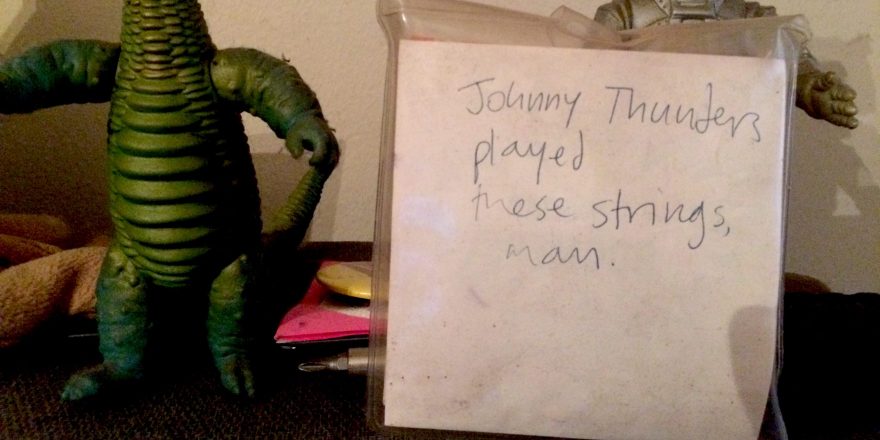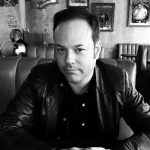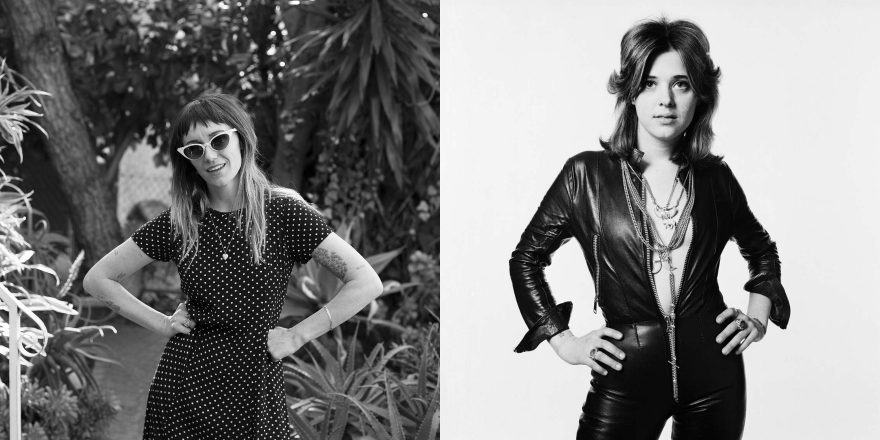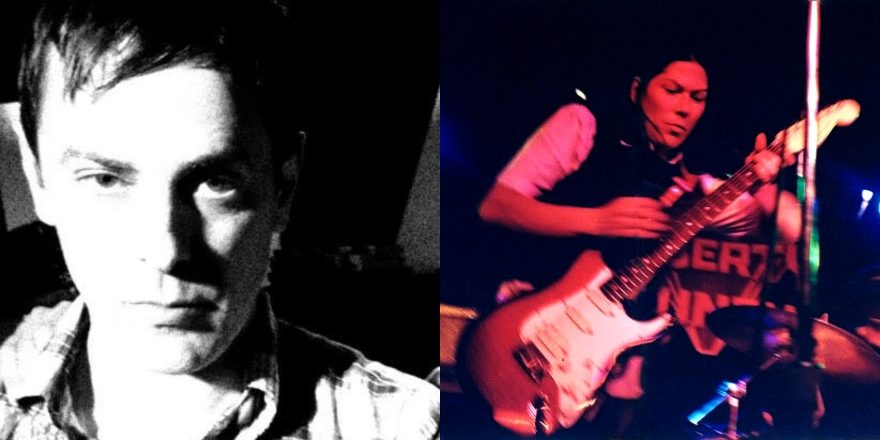Every now and again, when I’m digging through the layers of accumulated clutter in my apartment looking for something else, I’ll happen on the strangest, most evocative of all souvenirs of my band’s decades of touring. It’s a packet of crusty, rusted guitar strings, removed from the guitar on which they once were strung, recoiled and replaced in those little square paper envelopes and stuck in one of those plastic sleeves that strings come in. And on it is written: JOHNNY THUNDERS PLAYED THESE STRINGS, MAN.
And it’s quite true, he did, unlikely as it seems, even to me who was there when it happened. And therein, you know, as the saying goes, lies a tale.
Johnny Thunders was, of course, the guitar player of the New York Dolls, and later of the Heartbreakers. He was kind of like the American Keith Richards, or at least that’s how I saw him when I was a kid, though his guitar had a sound all its own, a distinctive, nasty, dirty, brittle yet lush kind of moaning tone sliding in and out of whatever music he happened to be playing. Moreover, despite the sonic grandeur, he played like he just didn’t care at all, like he just threw it all out there and let it shudder and quiver in the gutter while he walked casually away paying hardly any attention to it. This was what made him pretty much the coolest guy going. So he was my guitar hero from the first time I heard him sneeringly bend a string. (Not just mine, of course. I’m describing a pretty common response among the generation who came of guitar-playing age at the dawn of the punk rock era, I’m sure.)
I used to sing his solos and licks quietly to myself as I furtively moved through the middle school halls trying to avoid getting noticed by bullies, dreaming of a better world. (They are very sing-able.) When I was moping about a girl, which was quite often, the darker strains of his songbook’s introspective side loomed large in the soundtrack. “You can’t put your arms around a memory — don’t try.” This guy got me. I don’t know what I’d have done without him.
I made it through high school and eventually landed in my own dumb little band. I was no Johnny Thunders but I did what I could. In 1989, ten years after getting detention for carving “you can’t put your arms around a memory” (and “Free Keith Now”) into my English class desk, I found myself in the midst of our second attempt to tour the US, ostensibly to support our third release on Rough Trade records, an EP called Big Black Bugs Bleed Blue Blood. I say ostensibly because it is highly doubtful that this endeavor did anything to support anything. Touring, for such a band at such a time, wasn’t exactly living the rock & roll dream. The shows were small, when they happened at all. It wasn’t unusual to arrive at the venue written on the tour book only to be told they had no idea what we were talking about when we claimed we were supposed to be playing there that night. (Sometimes we’d talk our way on to the bill anyway; usually, we just got back in the van and moved on to the next mishap. But more commonly, we’d do our six-hour drive, unload our stuff from our dumb little van, play for an audience of around a dozen bemused, indifferent people, and pack it up again. If we were lucky, we’d get paid some “gas money” at the end of the night. Most people who have been in bands will tell you the same sort of story, it wasn’t just us. (Or so I like to tell myself.)
Quite often, we would arrive at the venue on our list and unload on to the stage thinking, hey, this is a pretty nice club, only to be told: “Oh no, you’re not playing in the main room, you’re playing in the basement.” The basement being a tiny, grimy pit with no stage and no monitors that smelled kind of weird. At least it felt like home.
And this was the case when we rolled up for our show in New York City. Our list said “CBGB,” the legendary club that spawned the NYC punk scene, the Ramones, Patti Smith, Blondie, the Talking Heads… You know what I’m talking about. We were excited, and kind of proud of ourselves. If it wasn’t the big time, it was hallowed ground, and it had a certain “real-ness.” We’d driven thousands and thousands of miles to virtually no avail, but this time at least it would be worth it, if only so we could say we’d done it. In fact though, it turned out we were playing not at the actual club like it said on the list, but at the CBGB “café” which was a literal coffee shop next door, very much like a Starbucks. Our gig was a kind of open mic night. The act on before us was a guy playing a violin.
We did our set, but I’m not going to lie: It was a low point, and I sure felt low. Maybe, I thought, it wasn’t worth it to have abandoned my education and career prospects and to have gambled my entire future on the fortunes of a band called the Mr T Experience.
Near the end of the set, our bass player Aaron elbowed me in the ribs and pointed. Johnny Thunders, the actual guy, had just walked in the door, along with Walter Lurie from the Heartbreakers and another guy who turned out to be called Philippe. Phillipe could be identified, by his P.R. shoes and big straw hat, as Johnny’s “man” (i.e. drug dealer) just like in the song. NYC rock & roll was assembling itself as a sort of tableau vivant before my eyes. I stared dumbly, waiting to see who else might walk in . . . Joey? Dee Dee? Handsome Dick Manitoba? When none did, we resumed playing our now rather disoriented Sesame Street cover and ended the shambles of a set. And here’s where the anecdote of our fleeting, genuinely yet ironically glorious brush with rock officially begins.
“Hey Philippe!” Johnny Thunders was saying as we started breaking down our stuff, pointing to a book in a rack of NY punk related titles. “There’s a whole book about me, a real book right there, all about me. Walter’s in it too.” It was a voice I knew quite well from live bootleg recordings of his baiting the crowd (“You kids are so boring, why don’t you take something, anything?”). It was kind of Edith Bunker with a dash of Jerry Lewis and Arnold Horshack, but, you know, cooler than that.
We chatted a bit, and he turned out to be rather spacey, but a lot nicer and less petulant that he was on the Live at the Speakeasy recording. We were star-struck, but he was pretty down-to-earth, and seemed to like being in the presence of people who recognized his greatness.
Things took a turn for the weird, though, when he said: “So, you guys want to jam a little bit or what?” I don’t know how to describe the surreal feeling. It was like handing your hat to Hank Aaron to sign and him saying “let’s go hit some fungos.” It was something I’d dreamed as a kid, now coming to life in a disturbingly literal way.
The sound guy summed it up, in a stern speech: “The show is over and we all really want to close up and go home. On the other hand, Johnny Thunders wants to play a song with you and I can’t find it in my heart to deny you that, which will probably end up being the highlight of your soon-to-be utterly forgotten career as a rock band.” He gave us three minutes max.
Our other guitar player, Jon von, knowing how much it meant to me, let me play his guitar while Johnny picked up my junky old SG. My amp was even junkier, a supremely crappy solid state Yamaha combo that sounded atrocious.
“No bass, no mids, just treble and volume, treble and volume,” said Johnny Thunders, pointing to the Yamaha’s knobs. And this was the most amazing part: Even with the lousy equipment, he sounded exactly like Johnny Thunders, a dank, lush, kind of “singing” tone. The guy was magic. “Blues in B flat,” he called out, and launched into the coolest blues intro I’d ever heard.
We scrambled to join in, but let’s put it this way: My band may have had its charms and hidden depths, but it wasn’t exactly the world’s greatest blues band. It went OK through the first few bars, but we were out of our depth, and then our drummer, easily distracted and rarely willing to stick to a basic beat for too long started doing some weird, flashy fills and then a half-time breakdown and everything quickly fell apart. Johnny Thunders started to look confused, then irritated; towards the end I even fancied I detected, in his eyes, a hint of existential remorse. Then his mind seemed to flee the scene. He started to sway a bit, and I wondered if he was going to fall down. He didn’t. He said “OK, that’s fine” and unslung the guitar. Our moment of glory was over. The whole thing lasted thirty seconds at most, well within the sound guy’s deadline.
It is often said that you shouldn’t meet your heroes, and what is usually meant is that they will fail you, by being unkind, or venal, or petty — that they will fail to live up to the ideal, which is better left preserved. Sometimes though, as with me and Johnny Thunders, it is you who fail them.
I’m not at all sorry it happened, though. Like the sound guy said, it was my band’s finest hour, warts and all, and possibly the greatest single incident in my life.
In the aftermath, Johnny Thunders signed Jon von’s tweed suitcase for carrying cords and such: “to Jon from John — don’t loose your wires.” The guy really couldn’t spell “lose.” What a legend. And I carefully removed and recoiled the strings, and labeled them so I wouldn’t re-use them myself (which is something I used to do in those days, as gas money rarely covered strings). The packet of strings and the story it symbolizes subsequently acquired a kind of folkloric status among followers of my own band. I’ve been offered large sums of money for it. But that’s not the kind of thing you sell. It’s just not. Maybe if the Smithsonian comes calling, we’ll talk.







